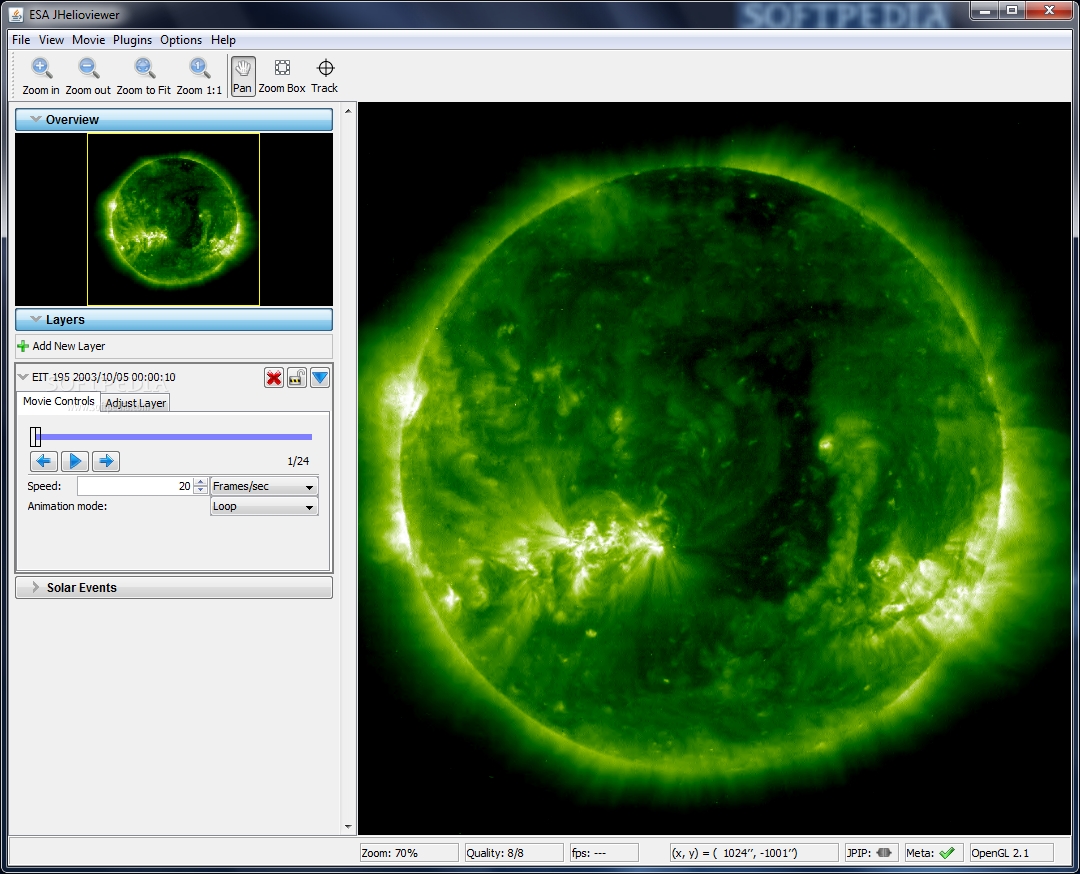
- JHELIOVIEWER PYTHON INSTALL
- JHELIOVIEWER PYTHON UPDATE
- JHELIOVIEWER PYTHON ARCHIVE
- JHELIOVIEWER PYTHON SOFTWARE
- JHELIOVIEWER PYTHON CODE
The detection of CMEs and filaments is accomplished with Solar and Heliospheric Observatory (SOHO)/ Large Angle and Spectrometric Coronagraph (LASCO) and ground-based Hα data, respectively. We also track the emergence and evolution of magnetic elements down to the smallest detectable features and will provide at least four full-disk, nonlinear, force-free magnetic field extrapolations per day.
JHELIOVIEWER PYTHON SOFTWARE
We produce robust, very efficient, professionally coded software modules that can keep up with the SDO data stream and detect, trace, and analyze numerous phenomena, including flares, sigmoids, filaments, coronal dimmings, polarity inversion lines, sunspots, X-ray bright points, active regions, coronal holes, EIT waves, coronal mass ejections (CMEs), coronal oscillations, and jets. The SDO data that we consider are all of the Atmospheric Imaging Assembly (AIA) images plus surface magnetic-field images from the Helioseismic and Magnetic Imager (HMI). In Fall 2008 NASA selected a large international consortium to produce a comprehensive automated feature-recognition system for the Solar Dynamics Observatory ( SDO). If you installed Helioviewer to /var/www/helioviewer, you can view the website at Vision for the Solar Dynamics Observatory ( SDO) To test the installation, open your web browser of choice and navigate to the location where Helioviewer is installed. It is recommended to use a virtual host configuration within apache to direct requets to the api under a subdomain. Modify the database credentials in the “Private.php” file with the values you entered in the installation GUI. Either set these parameters to “false”, or run Apache Ant on the “scripts/build.xml” file to build the necessary products:

JHELIOVIEWER PYTHON CODE
Modify the “Config.ini” file so that the information (filepaths, etc) accurately reflect your server configuration.īy default, the “compress_js” and “compress_css” parameters are set to “true” and Helioviewer will expect to find minified versions of the javascript code and cascading stylesheets. Example files, “” and “,” are provided which are intended to be used as a basis for your own configuration.Ĭopy or rename these example files to “api/settings/Config.ini” and “api/settings/Private.php”, respectively.
JHELIOVIEWER PYTHON ARCHIVE
Additionally, if you plan to use a JPIP server in conjunction with Helioviewer, a “movies” directory must be created within the JPEG 2000 archive so that generated JPX files may be accessed over JPIP.Įnable Apache to write to the directories:Ĭhmod 755 log cache jp2/movies Modify Config Fileīoth the front-end and back-end of use a single configuration file named “Config.ini”, in addition to a separate database configuration file, “Private.php.” Both of these files are located in the api/settings directory. Tiles, screenshots, and movies are stored in a “cache” directory and logs are stored in a “log” directory. In order to function properly, Helioviewer requires write-access to several directories. Kdu_merge Create Caching/Logging Directories Now try running one of the Kakadu tools to make sure everything was set up properly: Next, copy the Kakadu shared libraries and binaries to a known path, e.g.: Select the appropriate archive based on your architecture and extract the files: Kakadu binaries and shared libraries for 32-bit and 64-bit linux can be found in the install/kakadu directory. For a small dataset like the sample one provided above, processing should only be a matter of minutes. Processing the JPEG 2000 archive may take anywhere from several minutes to many hours depending on the size of the archives, and the number of files to be processed. If the MySQL daemon is not already running, start it:Ĭhange to the “api/install” directory and run the Helioviewer installation script:įollow the steps shown on screen. Tar zxvpf sample-data.tgz -C /var/www/jp2 If you don’t already have a JP2 dataset, you can download a sample dataset, e.g.: The next step is to process your JPEG 2000 (JP2) images and enter their information into the database for efficient querying.
JHELIOVIEWER PYTHON UPDATE
Git submodule update -init Setup the Database
JHELIOVIEWER PYTHON INSTALL
Pip3 install sunpy glymur zeep bs4 drms lxml numpy scipy datetime pandas bokeh=2.2.1 matplotlib pathlib joblib Clone source-codeĬlone the api repository into webroot usually located in “/var/www”Ĭlone the front-end repository into webroot usually located in “/var/www”Ĭd into the folder and run the following command to pull in

Sudo apt install apache2 php7.4 php7.4-mysql php7.4-curl php-pear php-imagick php-mbstring php-bcmath php-redis libapache2-mod-php mysql-server redis-server imagemagick python3-mysqldb python-tk python3-tk python3-pip ffmpeg git libpng-dev libgsf-1-114 git ant

This guide has been designed to work with Ubuntu 20.04 Prerequisitesįirst you will need to install all required packages.

However, if you wish to install the Helioviewer Project on your own machine this document has been created to aid you in this process.


 0 kommentar(er)
0 kommentar(er)
